The Role of a Software Architect on Your Team
Summarize:
Key takeaways
- Software architecture is the foundation of your project. A properly designed software architecture can prove your idea's viability, while poor architectural decisions can lead your project astray from the beginning.
- To develop the right architectural approach, you need an experienced software architect on your team. An architect’s responsibilities may vary, but typically, the software architect turns your vision into a technically feasible proof of concept (PoC).
- Software architects possess strong relationship, personal, business, and technical skills. They should have deep business and domain backgrounds to bring the most value to your project.
- Software architects take part in every stage of the SDLC. This role is essential for your project’s successful implementation and growth.
One of your first steps in building a software product will be to meet your project discovery team for the very first time at the project kick-off meeting. A software architect is one of the professionals you will get acquainted with at this meeting, and they will significantly impact your product’s implementation, launch, and growth.
But is it necessary to have a dedicated software architect?
What is the role of software architect, and what key responsibilities does it include?
Can you replace an architect with a software engineer?
We’ve prepared this comprehensive overview of the software architect roles and responsibilities to give you answers to these and many more questions, explore the concept of software architecture, and help you ensure that the architect who joins your project discovery team will bring unique expertise to your business.
Software architecture overview
Before we paint the portrait of a software architect, let’s consider the concept of software architecture.
You may find similarities between software architecture and building architecture. Your product may be like a residential building, with every step between deciding on the technologies and materials for construction and renting out the first apartment being an architectural decision.
However, there’s also a huge difference between architecting a building and a software app. A building is a static construction, while software is dynamic. It may change in size, form, and the environments where it is available.
Alan Tai, a software architect, explains that software architecture is more similar to city architecture:
“
The architect is the person who comes up with the design of the city, the plan of how it should be built, and how everything is going to fit together.
If you want someone to live in your city—or, in this case, use your app — you need an experienced software architect involved from the discovery phase services through each stage of your software development lifecycle.
You need an evolutionary architecture that can evolve as you and your team understand more about customer needs, the target market, and available development technologies.
In Design Patterns, Ralph Johnson says that “architecture is about the important stuff.” Let’s clarify why architecture is so important and why you need to have a well-thought-out software architecture from day one:
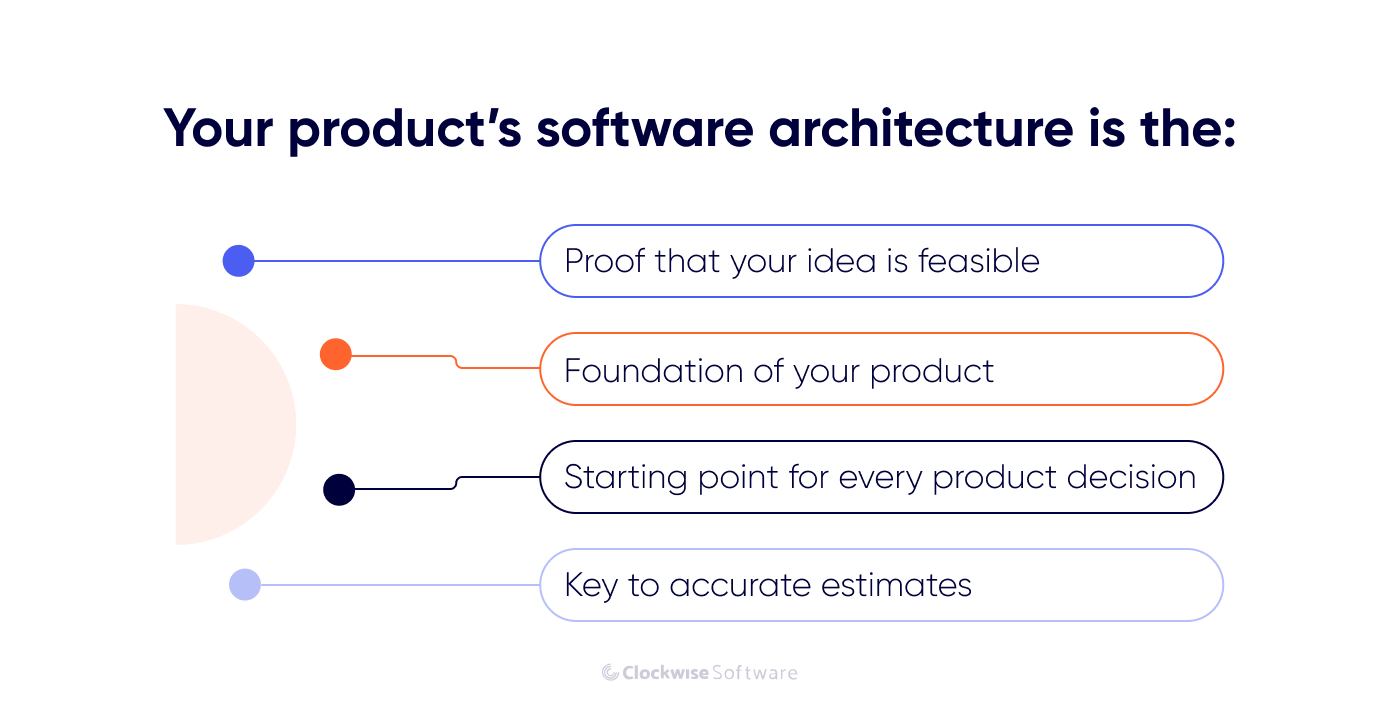
-
Software architecture is proof that your idea is feasible. You may have a picture-perfect app designed in Figma. But without a software architecture, you have the product interface but not the product itself. Designing the software architecture proves that you can implement an idea not only in terms of design but in terms of actual functionality.
-
Software architecture is the foundation of your product. Architectural modules, components, and the relations between them stand behind the working functionality. Every architectural decision helps the team to meet your product requirements.
-
Software architecture is the starting point for every product decision. Choices related to technologies, product scale, upgrades, migrations, and processes during custom software development depend on the chosen software architecture.
-
Software architecture is the key to accurate estimates. The architecture should reflect the complexity of the planned product. Based on an initial vision of the software architecture, your team can provide you with detailed web app development cost and time estimates.
According to your requirements, a software architect develops an architectural approach that defines the choice of development technologies; the way your users’ data will be stored, structured, processed, and secured; and future plans for improving and extending your product. Architecture is not just about the important stuff; it’s about all the stuff that is involved in product development.
You need a software architect on your team to develop the structure of your app and data storage, mitigate security and scalability risks, and facilitate your product and business growth.
The software architect’s role
What is a software architect? It’s an irreplaceable role to have in your engineering team.
Software architects are technical leaders who make architectural decisions on a project, provide technical guidance to stakeholders and in-house or outsource web development teams, and participate in making crucial product decisions.
In some cases, software architects may be intermediaries between engineering and business stakeholders, owning the technical vision of your idea.
An architect’s duties vary across organizations.
- In some teams, the most experienced engineer may make some architectural decisions and play the role of occasional software architect.
- In other teams, software architects may be responsible for technical and non-technical decisions, team management, and coaching activities.
- In some organizations, software architects are isolated from the development team, making them ivory tower architects.
- In seed-stage startup teams with no dedicated software architect, a development team may make architectural decisions collectively.
Read also:What Is Software Development Consulting?
In this article, we share a vision of the software architect’s role and responsibilities based on our experience with over 190 projects we have delivered to our partners and clients.
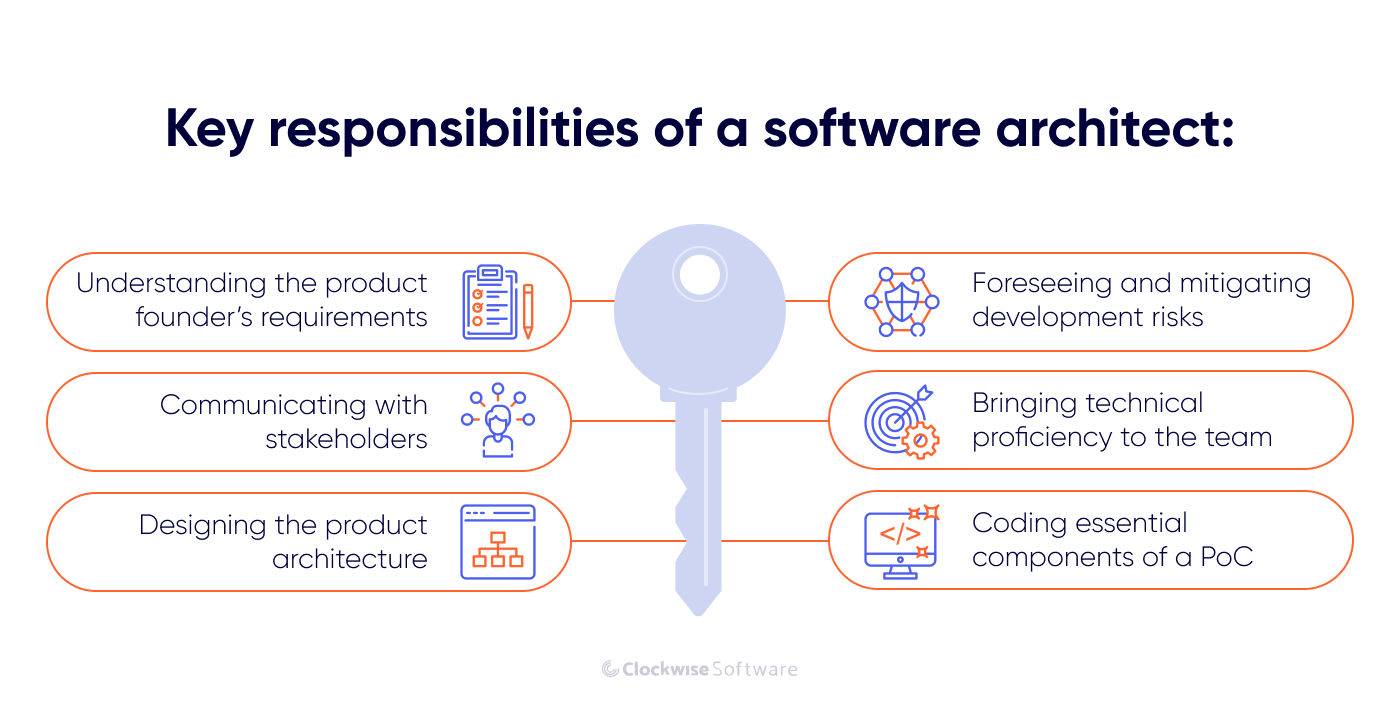
Software architects should know how to:
- Interpret your requirements. You have a strong product vision, and it is essential for a software architect to be fully aware of your requirements, have an understanding of target industry specifics, and ensure that stakeholders share the same idea of a product.
- Communicate and negotiate with stakeholders. From day one, a software architect makes decisions based on your functional and non-functional requirements and has to effectively communicate these decisions to both management and development teams.
- Design your product architecture. If you need to build an architectural approach from scratch, already have an up-and-running app, or need to rewrite your app or migrate it to other technologies or a new environment, your software architect must clearly see how to handle all related processes. The software architect should come up with multiple ways to implement your idea, compare them, and analyze the trade-offs to present the best solution to stakeholders and the development team.
- Foresee development risks and create plans to mitigate them. Software development may be a rocky road. At the initial stage, an engineering team defines technical risks and, together with an architect, develops ways to manage them.
- Bring high technical proficiency to the team. Typically, software architects have at least five years of experience as software engineers. On their way to this role, software engineers should follow the latest web development trends and advise on technical decisions, coach other software specialists, and play the role of tech leader if necessary.
- Code essential components of the proof of concept. As the most experienced engineers on the team, architects may be involved in critical engineering tasks. For example, architects may implement complex and essential parts of functionality in the PoC.
“
When I hire architects to work for me, I make sure that they are extremely technical and can code. This is because I expect the architects to be the first person that the development team turns to for advice on any problem.
These are only some of the essential responsibilities of software architects. Architects may also help to hire dedicated developers, document software architecture, and handle DevOps tasks.
Responsibilities may vary depending on the type of software architect:
- Enterprise architects are responsible for software in global companies that own numerous software solutions. These specialists may need to take an aerial view of the entire organization and all its products to ensure architectural designs align with each other and the company’s goals.
- Infrastructure architects mainly work with servers, network elements, and other tools and technologies that support the environment where your organization’s software and data are stored.
- Solution architects have less to do with coding. Instead, they dive into business requirements and generate solutions to meet them.
- Information architects focus on designing databases and developing data management systems. They are responsible for database performance and data security within organizations.
In this article, we focus on application architects — specialists that are familiar with all the responsibilities above, design your app’s architecture according to your app requirements, set up the environment for its successful operation, cooperate closely with the development and management teams, and ensure the planned app aligns with your business needs.
Read also:Software Development Team Structure
Software architect skills
In The Software Architect Elevator, Gregor Hohpe explains that an expert in software architecture has to rely on three so-called qualities:
- Skills – pure knowledge of the subject and an ability to solve real software problems with it
- Impact – how the architect can (or can’t) bring advantages to your company
- Leadership – action taken to master the art of architecting in a better way
In this section, we pay particular attention to a software architect’s skills.
Software architects are the most experienced engineers on a product team, yet they are not responsible for engineering tasks and focus on more critical decisions that impact not only your product but your whole business.
Gregor Hohpe emphasizes that architects are not senior developers.
“
Architects tend to have a broader scope, including organizational and strategic aspects, whereas engineers tend to specialize and deliver running software.
An architect’s soft skills are as important as their hard skills.
As you start thinking about how to hire a software architect, you may browse relevant profiles, job websites, and other websites where you can find app partners. In job descriptions, you may notice some common skills requirements mentioned by most companies:
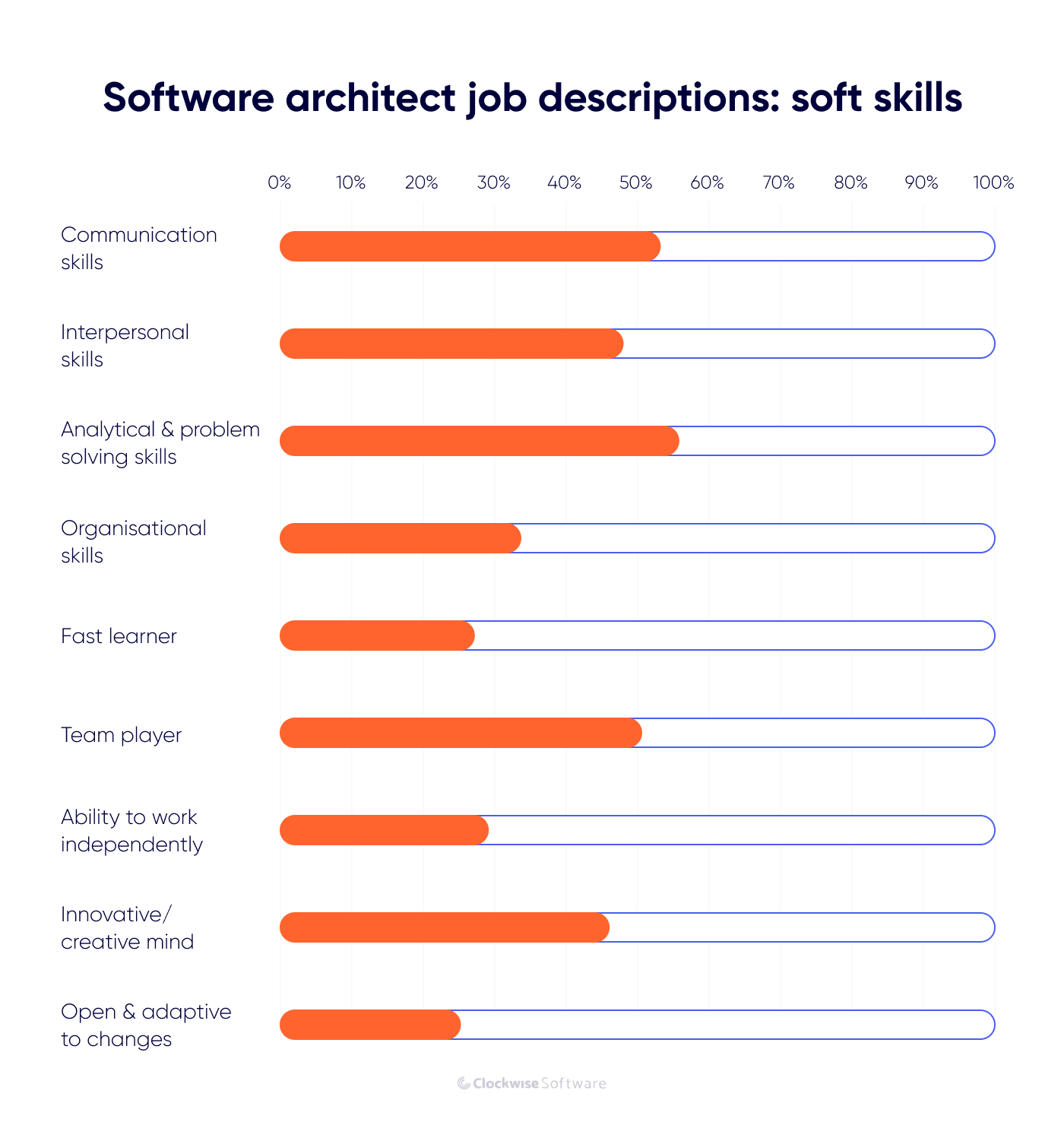
We’ve gone beyond the basic understanding of an architect’s skills and divided them into four major categories:
- Relationship skills
An architect’s responsibilities require high-level relationship skills to ensure a clear understanding of product ideas and their implementation among the team. According to 12 Essential Skills for Software Architects by Dave Hendricksen, this is what differentiates senior engineers from application architects.
- Integrity
In any project, integrity is critical. Being honest and open with a team not only gives credit to your software architect but also allows you and your development team to reach desired goals.
“
You and your team need to trust the person who develops your product architecture approach.
- Communication
Your software architect has to maintain daily interaction with your engineering team and may take part in project pitches and meetings with investors and stakeholders. Impeccable communication skills are a must for software architect role.
- Negotiation
At the same time, architects need to know how to say _no _and illustrate the reasoning behind their decisions. These decisions may block implementation of initial requirements. If your idea isn’t technically feasible, you may need to adjust your vision to something that is possible to implement. App architects are responsible for explaining the challenges as well as providing alternative ideas.
“
A software architect helps bring order where there is chaos, guidance where there is ambiguity, and decisions where there is disagreement.
- Leadership
Usually, architects don’t directly manage or supervise developers. Still, as more senior specialists, they may need to provide simple advice or mentoring depending on your team’s size and structure. A software architect may play the role of a leader in an engineering team and should be able to stand their ground and implement leadership strategies that may be best for your product.
- Personal skills
Tightly connected to relationship skills, personal skills are also of great importance.
- Open-mindedness
Software architects need to analyze alternative opinions and experiences to come up with the best ideas for implementing your project. By allowing other team members to contribute to the project and take ownership of certain ideas and decisions, architects can make your project better.
- Context switching
The product development environment is extremely fast-paced. To launch a better product faster than your competitors, your software architect may need to constantly switch between different tasks, responsibilities, and even projects.
- Pragmatism
Remember the concept of an MVP? It is essential to test assumptions as fast as possible, not to polish a piece of work for months without knowing whether the idea is going to work. An architect needs to prioritize tasks pragmatically, focus on business needs first, and be able to make decisions that are best for a software development company.
- Business skills
The software architect role requires both a business and technical background. The software architect is more than an engineer, and they should possess strong business skills:
- Domain knowledge
With a basic awareness of the target industry and market, a software architect may establish relevant vocabulary within a team and base decisions on real metrics and customers’ needs.
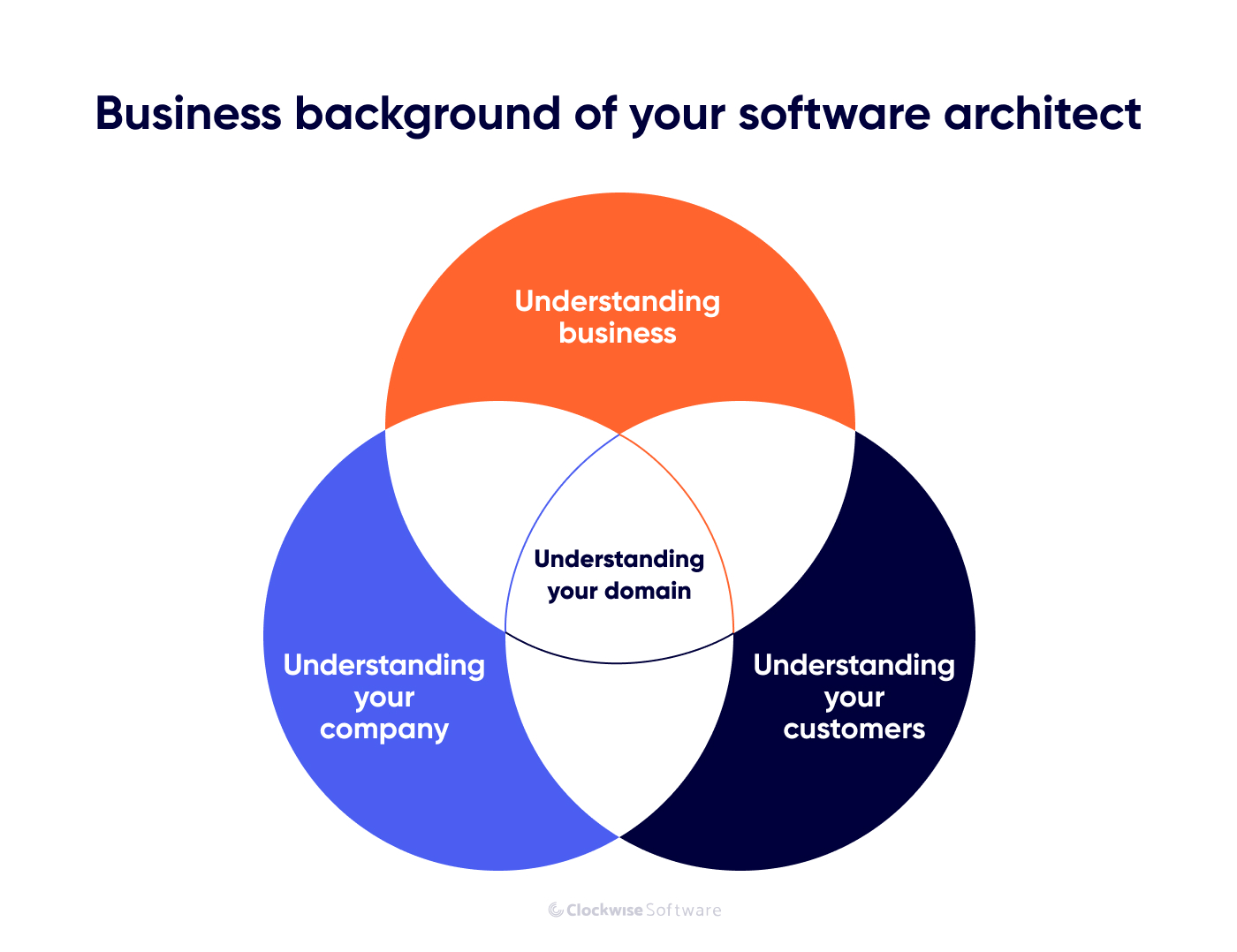
- Passion for innovation
For thousands of companies, 2023 has become the year of artificial intelligence (AI) and large language model (LLM) implementation. Those who haven’t yet thought about implementing AI in their business are lagging behind.
Your software architect should be aware of the latest AI and IT developments, the newest technologies, and general industry trends in order to implement cutting-edge solutions in your product.
- Technical skills
Software architects require two primary technical skills.
- Broad technical knowledge
Unlike a software engineer, who has deep experience in a single development technology, a software architect has deep experience in numerous technologies. To make critical engineering decisions, architects have to be able to compare many different approaches that may lead to the same results and select the most effective. Architects need to have experience in a variety of technologies to choose the right ones for your product.
- Background in architectural strategies, methods, frameworks, and patterns
Software architects may need to be skilled in data architecture and infrastructure architecture, cloud environment and DevOps principles, architectural frameworks and patterns, numerous programming languages, and more. Depending on your project needs, the list of tech skills may vary.
The role of software architect at different stages of the SDLC
Now, let’s have a closer look at what an architect does on your project, from the very first meeting to successful app deployment and beyond.
Project discovery phase
During the project discovery phase, an architect:
- Helps to identify ways to improve your product or solve your business challenges
- Contributes to the development of functional and non-functional requirements
- Ensures that the initial idea is technically feasible
- Selects the technology stack
- Contributes to project estimation
- Develops an architectural design
- Participates in risk assessment and mitigation planning
Project development and testing
In the SDLC, development and testing start when initial requirements are clear, well-documented, and reflected in the software design. A software architect:
- Sets development and quality standards
- Develops a design system to unify development components across teams
- Supports the team by advising on critical challenges
- Develops essential components of the software architecture
- Participates in release management
Project deployment
Once a piece of functionality is ready for deployment and team members push it to testing and production environments, the software architect faces a single major task: evaluating feedback about the app’s functionality and performance to understand if architectural decisions will impact it.
Further improvements
Project development is never-ending. You may need a software architect’s services even after your project goes live to:
- Address possible errors
- Participate in the next iterations of requirements elicitation
- Keep on making product improvements
Do you need a software architect on your team?
We analyzed our experience and prepared a brief answer to this question so you can apply it to your unique case:
You may not need a software architect if:
- You would like to build a simple app prototype for potential investors. Here, the focus is on simple: a visual prototype may describe basic screens of planned software and relations between them but has no back end. It may serve for basic presentations and attract attention to your idea.
- You would like to build basic software for your personal needs. If you have an engineering background, you can develop a custom calendar app or a personal blog on your own. Applications you don’t plan to scale and don’t expect to evolve in any way may get away without an architect’s contribution.
You need a software architect if:
- You plan to build a working, potentially profitable software product from scratch. Do you expect real users to download your software, use it, and recommend it to friends and colleagues? Or would you like to build an internal system to automate and improve operations within your company? In this case, a software architect is irreplaceable.
- You expect changes to requirements, customer needs, and application load. In an ever-evolving digital world, it’s crucial to stay one step ahead and have long-term plans for your business and software. When turbulence in a target industry and market are unavoidable, changes in software will be required. To face, handle, and implement them, you need an architect by your side.
- Your planned software must comply with industry-specific standards and regulations. No matter what type of software you choose to build, it has to meet not only your requirements but also laws and regulations in your country and industry. These may be related to payment functionality, user data collection, data processing and storage, geolocation features, and more. To make sure you build a software system that complies with legal requirements, you need an expert in software architecture on your team.
In the long run, a software architect may help you to optimize development time and even help to reduce software development costs.
If you’re still not sure whether you need to bring a software architect on your team, drop us an inquiry and we’ll provide you with a more detailed answer.
In conclusion
Now you know that a software architect is not just a senior software engineer. This specialist is also not a project manager, a technical leader, or a magical Gandalf who can fix any issue with your product in the blink of an eye.
A software architect is a technical expert on your team who’s responsible for high-level technical decisions and for developing the system, solution, and app architecture. A valuable expert, the software architect contributes to your product from product discovery to launch and beyond.
Software architects are highly skilled software engineers. Yet there’s a significant difference between these roles: architects have to demonstrate much stronger and better developed soft skills. They communicate the product idea to the engineering team and communicate engineering solutions to you and your co-founders, so impeccable communication, negotiation, leadership, and technical software architect skills are an absolute must.
Sources:
What it takes to become a Software Architect by Alan Tai
Design Patterns: Elements of Reusable Object-Oriented Software by Erich Gamma, Richard Helm, Ralph Johnson, and John Vlissides
The Software Architect Elevator: Redefining the Architect’s Role in the Digital Enterprise by Gregor Hohpe
12 Essential Skills for Software Architects by Dave Hendricksen
The Relationship Between Software Architecture And Business Models (and more) by Nick Tune
Software Architect’s Handbook by Joseph Ingeno
FAQ
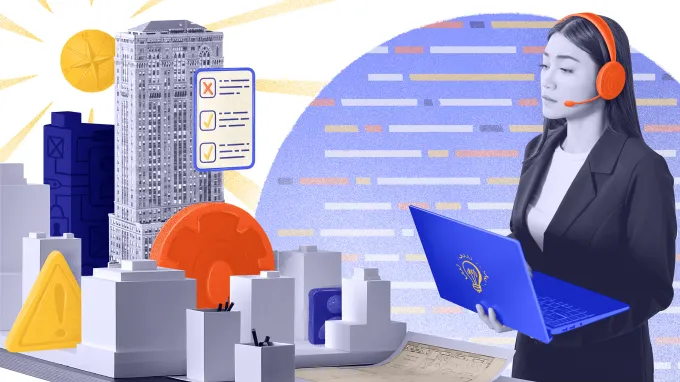
Any questions unanswered?
Let's discuss them
